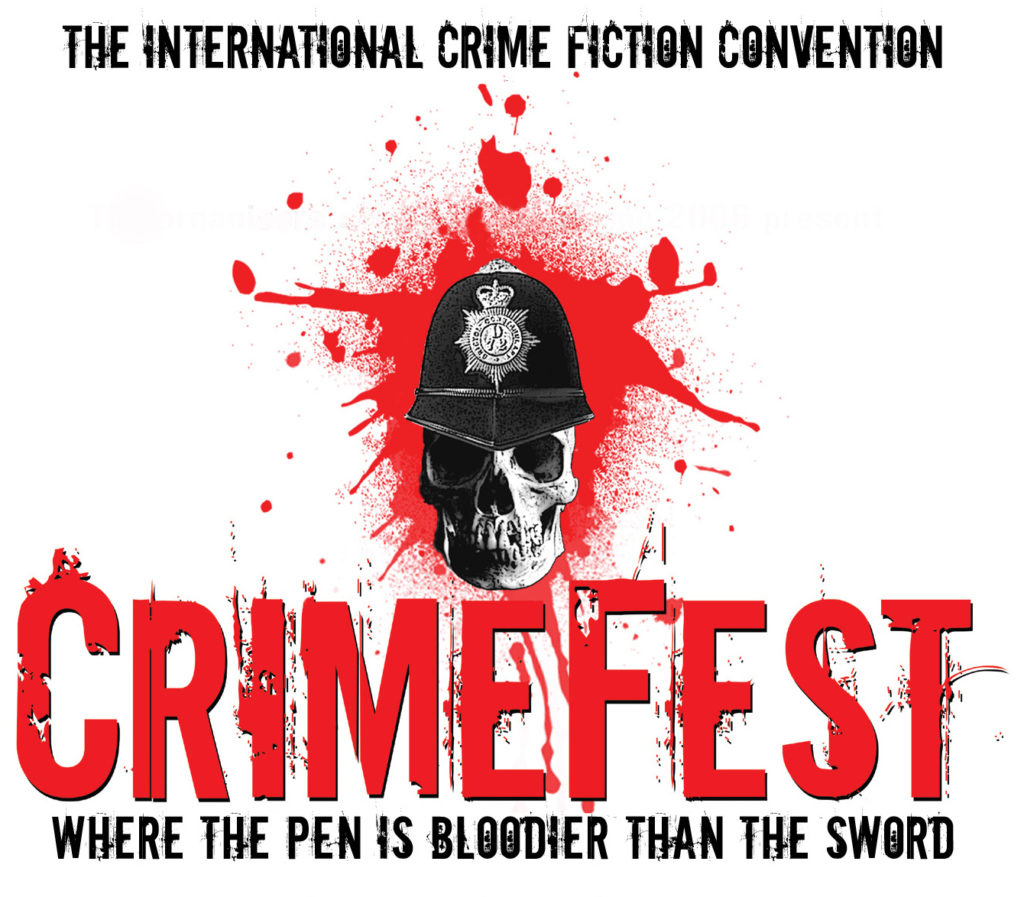(1) JAMES SALLIS Q&A. [Item by Bruce D. Arthurs.] Readers may find this recent interview with James Sallis on CrimeReads of interest. Includes a useful term, “arealist fiction”, I don’t think I’ve heard before. “Digging Deep, Staying with It: James Sallis on Writing, Reality, and the Danger of Creative Work”.
…For those readers familiar with Sallis primarily as the author of Drive (later adapted into an ultra-violent, neon-infused film with Ryan Gosling) and the Lew Griffin mystery novels, Bright Segments contains one big surprise: many of the stories are science fiction, a genre that Sallis has explored deeply throughout his life, bending it to his whims in all kinds of ways. There’s something in here for everyone, from the bleakly comedic “The Invasion of Dallas” (aliens find relationships just as confusing as humans) to the disquieting “New Teeth” (which comes off as a more ghostly “Do Androids Dream of Electric Sheep?”)….
…Q: You’ve said that the act of writing involves always challenging yourself, always pushing into new and potentially uncomfortable territory. What makes you uncomfortable on the writing front right now? What don’t you know what to do that you’re experimenting with?
JS: On the first day of every class I taught, I’d tell my writers “If you’re serious about this, if you dig in deep and stay with it, you will never be happy with what you write, you’ll always still be reaching.” The greatest danger of any creative work, it seems to me, lies in becoming professionalized, in learning how to do things, in failing to reach. The last time you wanted some effect or another, you did this—so you do it again, instead of taking this on as a new challenge to creativity. Stop. Let the cursor blink away. Put the paint brush down….
(2) BRADBURY 100. Phil Nichols is back with a new series of Bradbury 100 podcast episodes. Beginning with “Ray Bradbury on Stage!” (Direct Soundcloud link: “Bradbury 100 – Episode 58 – Ray Bradbury on Stage”.)

I get things started with a look at Ray Bradbury as a playwright, tracing his career asa theatre writer from the 1950s to the 2010s. I cover both successes and failures, and discuss both “faithful” and “playful” adaptations of his own work.
I have touched on some of this before – see episode 12, where I talked about Colonial Radio Theatre’s audio performances of Dandelion Wine and Something Wicked This Way Comes, which both used Ray’s plays (rather than his books).
And elsewhere on Bradburymedia you will find a review of a performance of Fahrenheit 451.
(3) NAME TO CONJURE WITH. Jules Burt encounters Glendale Paperback Show organizer (and legendary collector) Tom Lesser at the 21-minute mark of his video about “The London PAPERBACK + PULP Book Fair”.
The London PAPERBACK + PULP Book Fair – November 24th 2024 – What An AMAZING Show! Friends, in today’s video we take a look back at the incredible London Paperback and Pulp Fair as held on November 24th 2024. What an outstanding show. Incredible books, immense crowds, happy collectors! We have multiple interviews with dealers, collectors, authors and the show organisers. This is awesome! Thanks to Kim at etcfairs, Dorset Bob, Maurice at AllYouNeedIsBooks, Neil Pettygrew, Stephen Jones, Rian Hughes, Steve Holland of Bear Alley Books, Mick Cocksedge, Tom Lesser and everyone who came along and said hello – I salute you!
(4) VINTAGE PAPERBACK COLLLECTORS SHOW. And March 2025 is not that far away! Follow developments on Facebook.
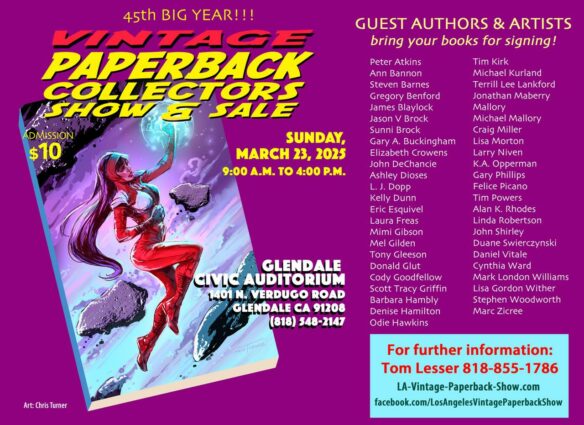
(4) COULD BE A VERY FINAL FRONTIER. “The Most Dangerous Locked Room of All? Space!” At CrimeReads, Lauren A. Forry finds, “Five reasons to take the traditional locked-room mystery to the stars.”
First reason:
1) Everyone is a suspect.
Yes, yes—in any mystery, many of the character are designed to be suspects. But when you have a murder in an isolated space— in literally isolated space—it really could be any one of them. They were the only ones there. No one could’ve snuck in. No one could have gotten away. There is no one else. It makes it that much more fun when you have to imagine that every character, even the ones that you love and are rooting for, could be the one that did it. And this makes the characters even more fun to write.…
(6) YOUNG LOVECRAFT ON ROBERT E. LEE, AND THE CLANSMAN. Deep Cuts in a Lovecraftian Vein brings us “H. P. Lovecraft, Three Letters to the Editor, 1909”. They are more or less rabidly racist, so be warned. These excerpts are from Bobby Derie’s analysis.
A nervous breakdown and poor attendance prevented H. P. Lovecraft from graduating high school in 1908. A spat in the letter columns of the Argosy led to Lovecraft joining amateur journalism in 1914. The period in between these events are the most mysterious of Lovecraft’s adult life. It is the era when we have the fewest letters to guide us on his daily activities, when he seems to have been the recluse that he later pretended to be….
…So it is always interesting to run across “new” letters from Lovecraft in this period. The digital archive of the Providence Journal in Rhode Island have revealed three letters from Lovecraft to the paper published in 1909….
… Although Lovecraft would not live to see the lies of Thomas Dixon, Jr. [author of The Clansman] overturned, Lovecraft would be around the birth of the second incarnation of the Ku Klux Klan in 1915, see its meteoric rise and its tremendous fall from grace. In time, the reactionary, pseudohistorical image of the American Civil War which emphasized States’ rights and de-emphasized the horrors of slavery would diminish. The Civil Rights Movement would push to complete the work begun during Reconstruction, and though great progress has been made, it has not been without decades of perseverance, violence, and setbacks. Racism is still deeply entrenched in U.S. culture.
An editor read this long letter from a 19-year-old Lovecraft and chose to publish it. Perhaps they agreed with him, perhaps they merely wished to cater to “both sides” in the debate over The Clansman play and book…
(7) TRINA KING. Longtime fan Trina King died November 21. At her request, this message was posted posthumously to her Facebook account.
To all of you, I offer my sincere and deepest apology for any wrongs I may have done to you. From the advantage of my old age, I cringe at how selfish and inconsiderate some of my behavior might have been. At the time, I was too insensitive to see how I was too self-contained to understand my words and actions.
So all I can do is hope you remember me as a better person than I really was.
Also, for those of you who think you could have talked me out of this, the answer is NO. This has been planned for years. I never wanted someone else to decide when I die. I always knew when the pain got too much and I could no longer take care of myself, then that was it. It has been too many years of living poorly.
(8) TODAY’S BIRTHDAY.
[Written by Cat Eldridge.]
Born November 27, 1907 — L. Sprague de Camp. (Died 2000.)
Let’s start with his excellent The Incorporated Knight series comprises some 1970s short stories by de Camp and two novels written in collaboration with his wife Catherine Crook de Camp, The Incorporated Knight and The Pixilated Peeress. The early short stories were reworked into first novel.
Next let me praise his Harold Shea and Gavagan’s Bar stories, both written with his friend Fletcher Pratt. There are five stories by them, another ten stories are written forty years later but not by them and I’m not at all fond of those. The original stories were first collected in The Compleat Enchanter: The Magical Misadventures of Harold Shea. Treasure them.
They say Gavagan’s Bar were patterned after Lord Dunsany’s Jorkens stories and that certainly makes sense. These are quite extraordinary tales. It appears the last printed edition is Tales from Gavagan’s Bar in 1980 on Bantam Books. Orion did a UK epub just several years ago and this year released one in the U.S.
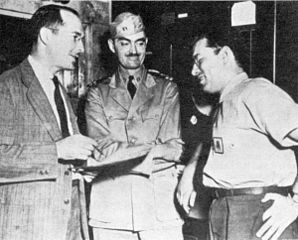
They did a lot of Really Good Stuff, say The Incomplete Enchanter and The Land of Unreason. An amazing writing partnership it was.
So, what’s good by him alone. Surprisingly his Conan tales are damn good. Now stop throwing things at me, I’m serious. Some are stellar like “The Frost Giant’s Daughter” and “The Bloodstained God”. (Yes, I’ve a weakness for this fiction.) The three Conan novels co-written with Lin Carter (Conan the Barbarian was also written with Catherine Crook de Camp) are remarkably resistant to the Suck Fairy.
Shall I note how excellent his Viagens Interplanetarias series is? Well, I will. Adventurous and lighthearted SF with great characters and fun stories, novels (much of which was written with his wife) and stories alike are great reads. I read a few stories a while back and even the Suck Fairy still liked them. All of his fiction holds up remarkably well despite being written upwards of six decades ago.
Well, that’s my personal reading history with him. What’s yours?
(9) COMICS SECTION.
- Saturday Morning Breakfast Cereal focuses on self-hatred of the humanities. (And yet we still call this a comic?)
- Glasbergen modernizes the Oz books.
- Non Sequitur claims a different origin for a familiar phrase.
- Speed Bump has surprising consequences.
- Macanudo demonstrates the magic of a book.
(10) HOGARTH ON SFWA. Author M.C.A. Hogarth has written a long thread at X.com intending to correct the record about why she stopped being an officer of SFWA. (See also File 770’s post from 2017, “SFWA VP M.C.A. Hogarth Steps Down; Hartshorn Fills In”, and Carl Slaughter’s interview from 2016, “M. C. A. Hogarth: Peltedverse Creator, Artist, and SFWA VP”.) Hogarth’s commentary begins:
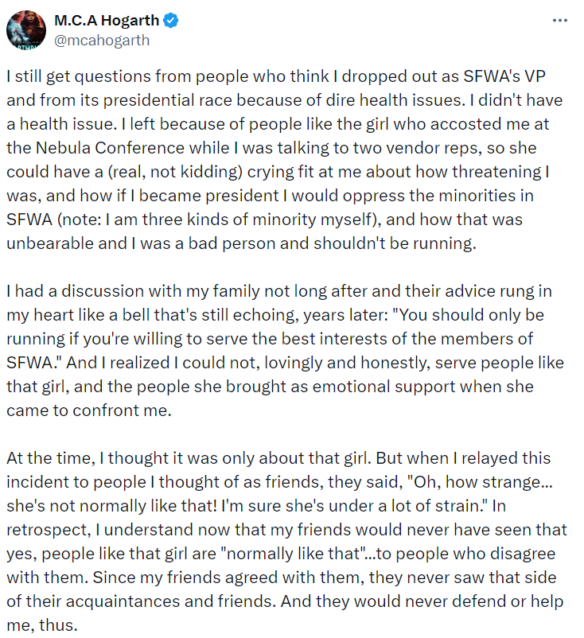
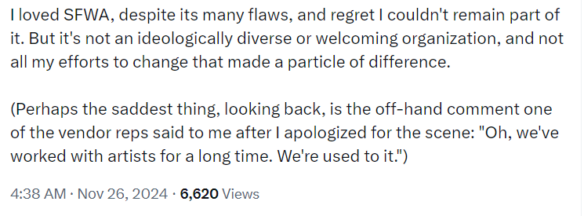
(11) WELCOME TO DYSTOPIA. Tr!llMag’s Charlott Batson’s “Our World Is A Mirror Of Dystopian Novels. Here Is Why” uses five very well-known books as illustrations.
Imagine waking up in a world where the lines between reality and dystopian fiction blur — where the fears once confined to the pages of classic novels now seep into our daily lives. Following the recent US election, is the world echoing the chilling warnings of authors like Orwell, Bradbury, and Atwood?
George Orwell has two books on this list. You don’t need to be told the first. The second one is –
Animal Farm by George Orwell
George Orwell’s Animal Farm is a story that explores how power can corrupt. The book tells the tale of farm animals that overthrow their human owner, as they feel they are not being compensated for all their hard work.
Part of their reasoning is that they work so hard, only to be slaughtered by man and never taste the fruits of their labor. However, this uprising is only focused on freedom for a short while before all animals end up under the harsh rule of the pigs. This change shows how even good intentions can lead to corruption.
Even today, the themes in Animal Farm are still relevant, as power and corruption begin to control our lives. The story shows how leaders can become selfish and betray the ideals they once supported. The pigs’ rise to power and their betrayal of the other animals highlight the need to hold leaders accountable.
This is particularly relevant following the recent US presidential election, where issues of corruption and the influence of money in politics were and continue to be hot topics.
Many people, predominately citizens of the US, are concerned about the potential for political leaders to prioritize their interests over those of the public. Animal Farm pictures and explains the horrors that this produces.
(12) WELL, WELL, WELL. [Item by Mark Roth-Whitworth.] I forsee oil companies funding space… “There May Be 5,000-Mile Deep Oceans On Uranus And Neptune, Scientist Says” – Forbes has the story. (May be paywalled.)
…Published this week in Proceedings of the National Academy of Sciences, a new study relying on computer simulations proposes that inside Uranus and Neptune — far below their thick, bluish, hydrogen-and-helium atmospheres — are layers of material that, like oil and water, don’t mix.
Over the years, planetary scientists have suggested that the ice giants contain diamond rain within them. The new theory suggests that instead, a deep ocean of water lies just below layers of clouds in the hydrogen-helium atmosphere. Below the water, goes the theory, is a layer of hydrocarbons — a highly compressed fluid of carbon, nitrogen and hydrogen. The layers are about 5,000 miles (8,000 kilometers) thick….
[Thanks to Steven French, Kathy Sullivan, Teddy Harvia, Bruce D. Arthurs, Joey Eschrich, Mark Roth-Whitworth, Mike Kennedy, Andrew Porter, John King Tarpinian, Chris Barkley, Cat Eldridge, and SF Concatenation’s Jonathan Cowie for some of these stories. Title credit belongs to File 770 contributing editor of the day Rob Barrett.]

